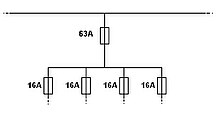Selectivity (circuit)
Selectivity means that in the event of a fault in a circuit of series- connected overcurrent or residual current protective devices, only the device that is located directly in front of the fault is triggered. It is a function of network protection . The selectivity ensures in a radiation network - i.e. in a power network that is fed from a central point - that as many parts of the electrical circuit or system as possible remain in operation despite the fault and only the fuse element in front of the fault location is triggered.
One differentiates
- Current selectivity , which is achieved through different levels of tripping currents in the protective devices, and
- Time selectivity , which is achieved through a different time delay in triggering the protective devices.
Fuses
"Two fuses connected in series behave selectively if their rated current differs by a factor of 1.6." Because the tripping behavior of fuses is subject to tolerances , fuses of directly adjacent rated current levels are not selective. The selectivity of fuses can only be reliably assessed on the basis of their time-current characteristics . As a rule of thumb , fuses are selective if their rated currents differ by two rated current levels.
In electrical systems, fuses with different nominal currents are usually installed, e.g. B. 16 A and 63 A.
This gradation ensures that only the fuse that is installed immediately in front of the source of the fault is triggered. Their rated currents, which have (at least) a ratio of 1: 1.6 (only for fuses), must be selected so that the fuses work “selectively” in their entire cut-off range.
Circuit breaker
Normal miniature circuit breakers trip immediately in the event of a short circuit , regardless of their rated current and their characteristics . The selectivity can only be achieved up to a certain overcurrent in the area of electromagnetic tripping and beyond this can no longer be ensured by the selection of the tripping characteristic. To achieve selectivity, a selective miniature circuit breaker can be connected before other miniature circuit breakers or fuses. Its release is delayed. However, it immediately limits the short-circuit current electromagnetically and can therefore also serve as backup protection . Normal miniature circuit breakers can be used as upstream fuses, but it is hardly possible to ensure that only the fuse that is immediately upstream of the fault is triggered. Depending on the type of device installed, both trip or it can even happen that the last fuse before the short circuit does not trip at all.
extension
In meshed networks or ring networks , in contrast to radial networks, there is the problem that a fault location is fed from two or more locations. The energy flow directions and the distances (distances) to the fault location, which is automatically determined by means of the loop impedance , then serve as additional triggering criteria for the delayed response behavior of the protective devices . The protective function is carried out by in-house measuring devices such as the distance protection relay , and the actual switching is carried out by remote-controlled circuit breakers .
Due to the problem of selectivity, ring lines in the medium-voltage network are often operated as an open ring when there is no fault, which is only closed in the event of a fault to maintain it up to the point of fault.
Evidence
According to the VDE, proof of selectivity must be provided in areas used for medical purposes (DIN VDE 0100-710) or in public facilities (formerly structural systems for gatherings of people) (DIN VDE 0100-718). The system operator can request this for systems that are not included. In principle, it makes sense to achieve selectivity when setting up / changing a system.
literature
- Gerhard Kiefer: VDE 0100 and practice . 1st edition. VDE-Verlag, Berlin and Offenbach 1984, ISBN 3-8007-1359-4 .
- Ernst Hörnemann, Heinrich Hübscher: Electrical engineering specialist training in industrial electronics . 1st edition. Westermann Schulbuchverlag, Braunschweig 1998, ISBN 3-14-221730-4 .
- Gerhard Brechmann u. a .: Electronics tables for operating and automation technology . 1st edition. Bildhaus Schulbuchverlag, Braunschweig 2006, ISBN 978-3-14-235035-6 .
- Hermann Wellers: Expertise in electrical professions, complete range for industrial engineering, energy and building technology, and automation technology . Troisdorf 2009, ISBN 3-8242-4290-7 .
Footnotes
- ↑ Hermann Wellers: Fachkunde Elektroberufe, complete volume for operating technology, energy and building technology as well as automation technology, Troisdorf, 2009, p. 563
